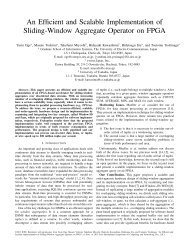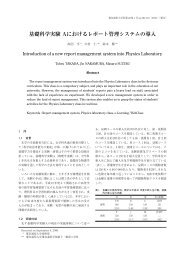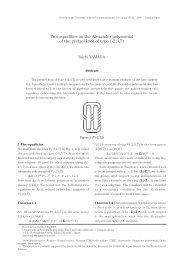Approximation of Hessian Matrix for Second-order SPSA Algorithm ...
Approximation of Hessian Matrix for Second-order SPSA Algorithm ...
Approximation of Hessian Matrix for Second-order SPSA Algorithm ...
You also want an ePaper? Increase the reach of your titles
YUMPU automatically turns print PDFs into web optimized ePapers that Google loves.
1.3 INTRODUCTION TO <strong>SPSA</strong> ALGORITHM<br />
One properly generated simultaneous random change <strong>of</strong> all p variables in the problem contains<br />
as much in<strong>for</strong>mation <strong>for</strong> optimization as a full set <strong>of</strong> p one at time changes <strong>of</strong> each variable [13].<br />
Further, <strong>SPSA</strong>—like other stochastic approximation methods—<strong>for</strong>mally accommodates noisy<br />
measurements <strong>of</strong> the objective function. This is an important practical concern in a wide variety<br />
<strong>of</strong> problems involving Monte Carlo simulations, physical experiments, feedback systems, or<br />
incomplete knowledge. The need <strong>for</strong> solving multivariate optimization problems is pervasive in<br />
engineering and the physical and social sciences. The <strong>SPSA</strong> algorithm has already attracted<br />
considerable attention <strong>for</strong> challenging optimization problems where it is difficult or impossible<br />
to directly obtain a gradient <strong>of</strong> the objective function, not on measurement <strong>of</strong> the gradient<br />
objective function. As we mentioned above, the gradient approximation is based on only two<br />
functions measurements (regardless <strong>of</strong> the dimension <strong>of</strong> the gradient vector). There<strong>for</strong>e,<br />
contrasts with standard finite-difference approaches, which require a number <strong>of</strong> function<br />
measurements proportional to the dimension <strong>of</strong> the gradient vector.<br />
The <strong>SPSA</strong> is generally used in non-linear problems having many variables where the objective<br />
function gradient is difficult or impossible to obtain. As a SA algorithm, <strong>SPSA</strong> may be<br />
rigorously applied when noisy measurements <strong>of</strong> the objective function are all that are available.<br />
There have also been many successful applications <strong>of</strong> <strong>SPSA</strong> in settings where perfect<br />
measurements <strong>of</strong> the loss function are available.<br />
Fig. 1.2. Per<strong>for</strong>mance <strong>of</strong> <strong>SPSA</strong> algorithm (two measurements).<br />
9

















